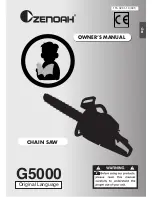
ICFR – Chainsaw Safety and Operating Handbook
35
Step 5 – branch 5 – topside across and away from
the operator
Rest the chainsaw against the stem. Use the thumb on
the throttle. Cut the branches on the top side using the
top of the guide bar. Beware of kickback.
Step 6 – branch 6 – farside – downwards
The chainsaw now slides down to the farside branches.
Rest the chainsaw against the stem and cut with the
bottom of the guide bar. Keep the guide bar on the
opposite side of the stem whilst repositioning for the
next sequence.
Repeat Steps 1 to 6 once more, if required.
If the distance between branches is too great to follow
steps 1 to 6, stop after step 3. Move the chainsaw to
the far-side of the stem, move position and start the
next sequence with branch 1.
Underside
Position the feet facing backwards towards the stump
or thick end with the right foot pointing towards it.
Support the saw by resting the arms against the knees/
thighs. Sweep from left to right underneath the stem
cutting the branches as flush as possible.
Once the underside has been debranched, keep the
chain pulling on the stem, sweep the guide bar over
the stem with the chainsaw supported against the knee
keeping the left arm in an extended position. Normally
the underside is debranched after two debranching
sequences 1 to 6.
Be alert for branches that may pinch the guide bar due
to their weight or tension that has been put on them.
These branches may first need to have the tension
removed by an opposite cut before reverting back to
the underside.
If underside debranching cannot be done as part of
the integral debranching sequence, turn the stem
over (with a felling lever/canthook or other suiable
tool) after the large branches have been cut and then
complete debranching.
11.6.2
d
ebrAnching
thick
brAncheS
In some cases it can be difficult to use the lever method.
This is often true with heavy, splayed branches. To
avoid pinching the guide bar, cut the branches in
stages starting from the outside. This results in the
weight being removed before the heavy cut closest to
the stem is made.
The methods used for debranching thick branches
are often quite similar to the cross-cutting method
described in section 12.
Pinching and splitting can be minimised by debranching
thick branches in the following order:
•
Step 1:
Cut off branches which may hinder
the operator by getting in the way.
•
Step 2:
Cut off branches with high internal
stress. These branches are often cut
in stages to relieve the tension.
Figure 39: Debranching thick branches
•
Step 3:
Finish off by cross-cutting the main
branch.
Use the right method.
Keep in mind that branches can be
under considerable tension.
Keep the guide bar vertical to
reduce the risk of pinching. If the
branches are very large it may be
necessary to make cuts from two
different directions in order to
avoid pinching and splitting.
















































